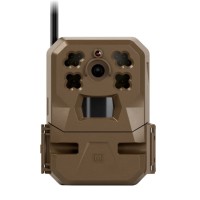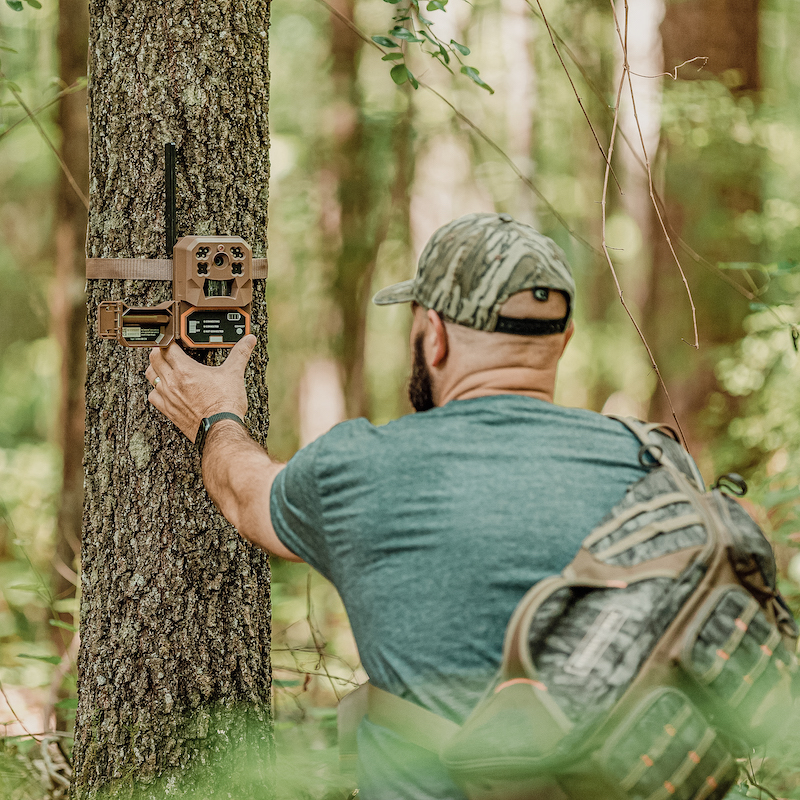
Trail cam technology has come a long way since the tripwires of the 80s.
While early models could only record a single event per setup, modern cellular cameras can transmit hundreds of images and videos to help hunters take inventory of herds from across the country.
Jump to: The Trail Cameras We Use
What We Look for in a Good Trail Camera
We’ve put dozens of different trail cameras through the paces over the years. Some spat out indiscernible images, and others failed to take any photos at all. But the trail cameras we continue to keep in our toolbelt all have a few things in common.
- Speed
- Image Quality
- Battery Life
- User-Friendly Features
We’re looking for a quality camera that can capture crisp photos quickly, ride out many months without a battery or card swap, and make management a breeze.
Jump to: What Makes a Good Trail Camera
The Trail Cameras We Use
The MeatEater crew has hung these trail cameras in whitetail woods throughout the country, and they’ve been reliable scouting tools.
 Exodus Render 4G LTE
Tony’s Pick
|
 Tactacam Reveal X
Mark’s Pick
|
 Bushnell Core DS-4K Janis’s Pick
|
 Moultrie Mobile Edge
Emily’s Pick
|
|
|---|---|---|---|---|
| Highlight | Best Overall | Most Reliable | Best Non-Cellular | Best Budget |
| Trigger Speed | Speed: 0.3 s | 0.5 s | 0.15 s | 0.85 s |
| Detection Range | 70 ft. | 96 ft. | 120 ft. | 80 ft. |
| Photo Resolution | 3, 5, 8, or 15 MP | 8, 12, or 16 MP | 32 MP | 33 MP |
| SD Card Compatibility | Up to 64 GB | 16-32 GB | Up to 512 GB | N/A |
| Price | $335; data plans from $3/month and $7 line fee* | $139.99; data plans from $5/month * | $199.99* | $99.99; data plans from $7.99/month * |
| Field Notes | Field Notes | Field Notes | Field Notes |
What Makes a Good Trail Camera
Whether you want a premium cellular camera with all the bells and whistles or a standard model that simply gets the job done, any trail camera worth its salt will measure up based on the following criteria.
1. Speed
If you only end up with single photos of deer backends, your trail camera probably doesn’t have adequate trigger speed or recovery time. The best trail cameras will capture a photo almost immediately after detecting movement—ideally within a half-second—and be capable of taking the next photo within another second or two. Fast transmission times in cellular cameras can also provide real-time data to help you determine exactly what time of day deer are moving by your stand.
2. Image Quality
Rather than taking grainy, blurry images, a good trail camera should provide crisp photos and videos without clogging up memory with huge file sizes. A lot of the action will occur after dark, so cameras equipped with black or IR flash and considerable night detection range are best.
3. Battery Life
The less you disturb your hunting areas, the better. But even if you opt for a cellular camera, you could be stuck traipsing past your stand to replace batteries on a regular basis—and cold weather can kill them even faster. A good trail camera will offer several months of battery life, often with the help of lithium batteries, the option to double up on batteries, external power sources such as solar panels, or optimized settings. The ability to check battery level remotely is helpful too.
4. User-Friendly Features
You shouldn’t have to be super tech savvy to set up a trail camera. The best trail cameras will offer an intuitive quick-start process and make it easy to adjust settings on the fly. Mobile apps can simplify—or further complicate—these processes when paired with cellular cameras. A worthwhile one will allow you to tweak settings, check battery level, and manage photos and videos quickly and easily.
Trail Cam Legality & Fair Chase
While a few states have completely banned trail cameras for hunting, others have restricted the use of cellular or wireless models, citing fair chase ethics.
Currently, it’s illegal to run any trail cameras in Utah, Nevada, or Arizona for hunting purposes—although there are some different nuances to the regulations in each state.
Hunters in states such as Montana, New Hampshire, and Alaska are prohibited from using cellular trail cameras in-season to act on real-time data (in some places, they must wait until the next day after receiving images).
As trail cameras become more and more capable, state agencies continue to evaluate the effects of this technology on wildlife management and adjust regulations.
Organizations such as the Pope & Young Club have spoken out against the manipulation of cellular camera technology. While the Club doesn’t discourage the use of trail cameras in general, it recognizes that immediately responding to a real-time wireless image in order to kill an animal would be a violation of fair chase rules.
Trail cameras can be incredibly helpful tools, but their legality and ethicality aren’t exactly cut and dried. Before buying a trail camera, be sure to check regulations in the states you plan to hang them.
Field notes from the MeatEater Crew
Tony’s Pick
Best Overall
For an all-around workhorse that allows for customization, Tony relies on the Exodus Render 4G LTE.
"I put out a couple of these cameras this summer on a property in Wisconsin, and they've delivered crisp imagery without any hiccups since then," he said. "Setup is pretty simple, and it seems like the trigger speed and event-capture rate with these cameras is second-to-none."
The camera pairs with the Scoutek app for simple, complete control and adjustment from anywhere, and it’s compatible with the Exodus SP18 solar panel for extended battery life.
It also comes with a 5-year theft and accidental damage warranty, so you don’t have to stress if your camera suddenly grows legs.
"The Render 4G isn't the cheapest cell camera on the market, but it's worth the money."
Specifications
- Trigger Speed: 0.3 s
- Detection Range: 70 ft.
- Photo Resolution: 3, 5, 8, or 15 MP
- SD Card Compatibility: Up to 64 GB
- Price: $335
Mark’s Pick
Most Reliable
There’s nothing worse than anxiously awaiting trail cam photos only to learn the tech just isn’t working. But Mark hasn’t had that issue with the Tactacam Reveal X.
"The Tactacam cell trail cameras are my favorite mostly because they just work," he said. "Better than any other cell cam I've used yet, they do their job, do it consistently, and don't have problems."
Operating on AT&T or Verizon nationwide 4G/LTE networks, the Tactacam Reveal X is certified IP66 waterproof and captures quality images in all conditions.
"It's simple to set up and use, the app is intuitive, and they get the strongest, most consistent cell service that I've experienced yet," Mark siad. "I trust Tactacams—I can't say that for every trail cam."
Specifications
- Trigger Speed: 0.5 s
- Detection Range: 96 ft.
- Photo Resolution: 8, 12, or 16 MP
- SD Card Compatibility: 16-32 GB
- Price: $139.99
Janis’s Pick
Best Non-Cellular
For hunters who will occasionally leave a trail cam out for summer scouting and want an easy-to-use yet high-performance option, the Bushnell Core DS-4K belongs at the top of the list.
"I've only used three trail cams in my life, but of those three, the Bushnell Core DS-4K was my favorite," Janis said. "It has the easiest controls as well as the highest-quality photos and videos. Easy setup, great results."
The standard trail camera won’t send images to your phone, but it boasts top trigger speed, recovery rate, detection range, video resolution, and memory capacity.
And with lithium batteries, the Core DS-4K offers up to 12 months of battery life.
Specifications
- Trigger Speed: 0.15 s
- Detection Range: 120 ft.
- Photo Resolution: 32 MP
- SD Card Compatibility: Up to 512 GB
- Price: $199.99
Emily’ Pick
Best Budget
When you’re running lots of cameras, scouting public land, or just don’t want to blow your hunting budget on trail cams, a solid performer that rings in under 100 bucks fits the bill.
The Moultrie Mobile Edge is an affordable option and saves me even more with its internal memory system that eliminates the need for SD cards.
The camera uses Auto Connect Technology to scan several major cellular carriers for the strongest network available with a single SIM card. So no matter where you hang it, you have the best odds of transmitting photos and videos.
It can run on eight AA batteries but also offers the option to install 16 to extend battery life up to a year.
The Edge is easy to use and pairs with the Moultrie Mobile App for more functionality. It might not be the flashiest trail cam out there, but it’s a great value.
Specifications
- Trigger Speed: 0.85 s
- Detection Range: 80 ft.
- Photo Resolution: 33 MP
- SD Card Compatibility: N/A
- Price: $99.99














